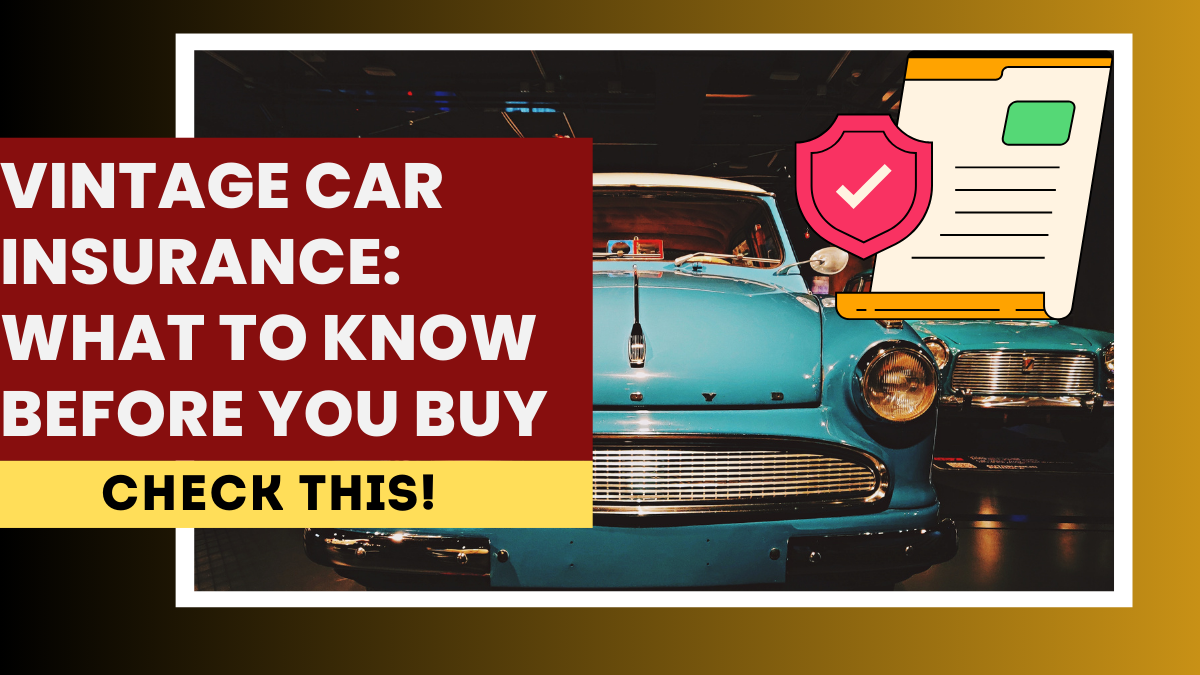Owning a vintage car is not just about passion; it is also about responsibility. These vehicles often represent decades of history, unique craftsmanship, and significant financial value. Unlike modern daily drivers, they require specialized protection to safeguard both their worth and their owners’ peace of mind. That is where vintage car insurance tips come into play. Understanding how policies for classics differ from standard auto insurance, what coverage options exist, and how to secure the best rates is essential for any collector or enthusiast.

Why Vintage Cars Need Special Insurance
Standard car insurance policies are designed for vehicles that depreciate over time. Vintage cars, however, often appreciate in value or hold steady at higher market rates. A traditional policy may only cover the book value of a car, which could be far lower than what it would cost to repair or replace it. Specialized policies for classic vehicle coverage consider rarity, authenticity, and collectible value, ensuring that owners are properly compensated if something goes wrong.
Agreed Value vs. Actual Cash Value
One of the most important distinctions in old car insurance guides is between agreed value and actual cash value.
-
Agreed Value Coverage: The insurer and owner agree on the car’s value at the time the policy is written. If the vehicle is damaged beyond repair, the agreed amount is paid, without depreciation deductions.
-
Actual Cash Value: This is typical of regular insurance policies and considers depreciation. For vintage cars, this often underrepresents true worth.
Collectors overwhelmingly prefer agreed value policies because they reflect market reality and protect investments more effectively.
Eligibility for Vintage Car Insurance
Not every older car qualifies for classic insurance. Insurers typically impose certain conditions, such as:
-
The vehicle must be at least 20–25 years old.
-
It cannot be a primary mode of daily transportation.
-
It should be stored in a secure garage or covered facility.
-
Owners must maintain a clean driving record.
-
Limited annual mileage, often between 2,500 and 7,500 miles.
Meeting these requirements ensures lower premiums compared to standard auto insurance, since insurers assume reduced road risk.
What Vintage Car Insurance Covers
Policies can vary, but most include coverage tailored to classic vehicle needs:
-
Comprehensive Coverage: Protection against theft, fire, or vandalism.
-
Collision Coverage: Repairs or replacement after an accident.
-
Spare Parts Coverage: Vintage cars often need rare parts, and policies may cover these separately.
-
Restoration Coverage: Protects vehicles under restoration, covering damage during work.
-
Event and Exhibition Coverage: Ensures protection during rallies, car shows, and parades.
These additional options highlight the difference between normal auto insurance and specialized vintage coverage.
How to Get the Best Rates
Owning a vintage car does not mean paying sky-high premiums. By following these vintage car insurance tips, owners can secure the best value:
-
Compare Specialized Insurers – Companies like Hagerty, Grundy, or American Collectors Insurance focus on classics and often provide better rates than mainstream insurers.
-
Bundle Policies – Insuring multiple cars or combining with home insurance can reduce costs.
-
Demonstrate Secure Storage – Keeping your car in a climate-controlled garage often results in discounts.
-
Limit Mileage – The less you drive, the lower your premiums.
-
Join Car Clubs – Membership in recognized vintage car clubs sometimes qualifies you for reduced rates.
Common Mistakes to Avoid
Enthusiasts new to vintage ownership often make errors when insuring their vehicles. The most common mistakes include:
-
Using standard auto insurance instead of a specialized policy.
-
Underestimating the car’s value, leaving them underinsured.
-
Failing to update policies after restorations or modifications.
-
Ignoring the fine print about usage restrictions, which can void coverage if broken.
Case Example: Why Specialized Insurance Matters
Consider a collector who owns a restored Jaguar E-Type valued at $120,000. A standard policy may classify the car at only $25,000 based on age, offering a fraction of its worth in case of a total loss. With an agreed value vintage policy, the full $120,000 would be covered. This example demonstrates the importance of proper classic vehicle coverage for high-value cars.
When to Review Your Policy
Insurance for vintage cars is not static. Owners should review their policies at least once a year, especially if:
-
The market value of their car has risen.
-
They completed restorations that increased the car’s worth.
-
They plan to drive more frequently or attend new events.
Regular updates ensure coverage always matches the car’s true value.
Final Thoughts
Securing the right insurance is one of the most important responsibilities of owning a classic vehicle. The right policy not only protects financial value but also offers peace of mind when showcasing or driving your prized possession. By following this old car insurance guide, collectors can understand their options, avoid common mistakes, and ensure their car is covered for every possible scenario. A well-protected vintage car is not just a hobby; it is a legacy preserved for future generations.
FAQs
Do all vintage cars qualify for special insurance?
No, cars must meet eligibility requirements such as age limits, secure storage, and limited mileage.
Is vintage car insurance cheaper than standard insurance?
Often yes, since these cars are driven less frequently, but rates depend on storage, value, and driving history.
Can I drive my insured vintage car daily?
Most policies restrict daily commuting, but occasional leisure drives and shows are covered.
How is the value of my vintage car determined?
Through an appraisal or agreement between the owner and insurer, ensuring coverage reflects true market value.
Click here to know more.
